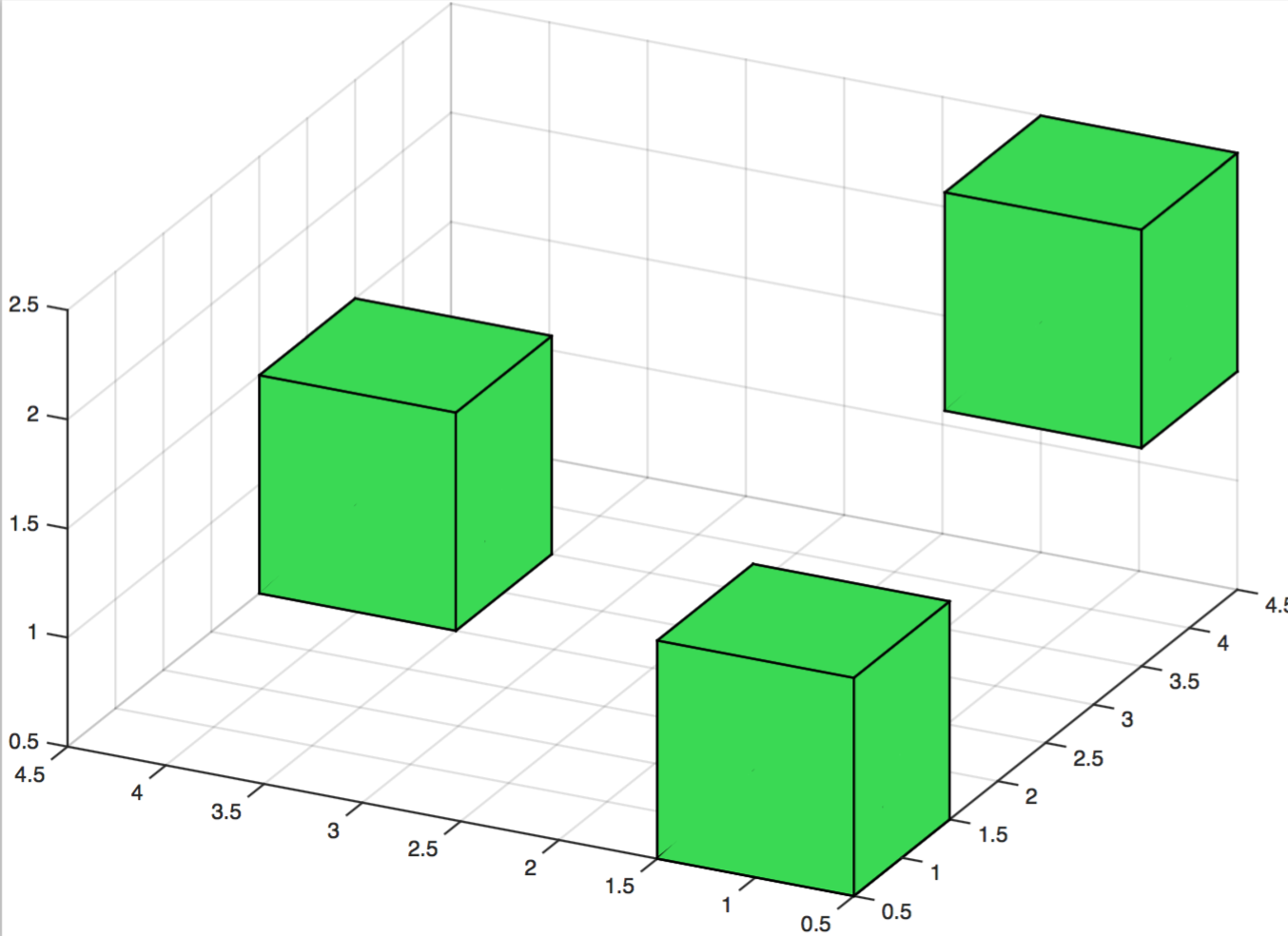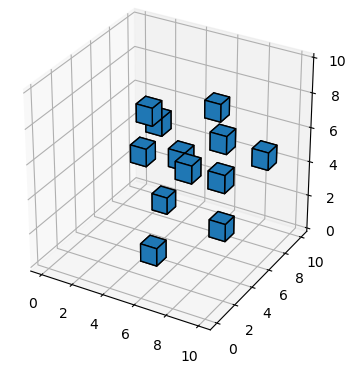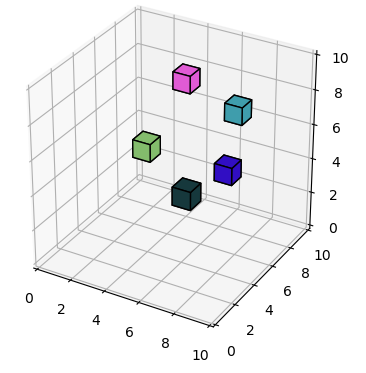A. Using voxels
From matplotlib 2.1 on, there is a Axes3D.voxels function available, which pretty much does what's asked for here. It is however not very easily customized to different sizes, positions or colors.
from mpl_toolkits.mplot3d import Axes3D
import numpy as np
import matplotlib.pyplot as plt
N1 = 10
N2 = 10
N3 = 10
ma = np.random.choice([0,1], size=(N1,N2,N3), p=[0.99, 0.01])
fig = plt.figure()
ax = fig.gca(projection='3d')
ax.set_aspect('equal')
ax.voxels(ma, edgecolor="k")
plt.show()
![enter image description here]()
To place the voxels at different positions, see How to scale the voxel-dimensions with Matplotlib?.
B. Using Poly3DCollection
Manually creating the voxels may make the process a little bit more transparent and allows for any kind of customizations of the sizes, positions and colors of the voxels. Another advantage is that here we create a single Poly3DCollection instead of many, making this solution faster than the inbuild voxels.
from mpl_toolkits.mplot3d import Axes3D
import numpy as np
import matplotlib.pyplot as plt
from mpl_toolkits.mplot3d.art3d import Poly3DCollection
def cuboid_data(o, size=(1,1,1)):
X = [[[0, 1, 0], [0, 0, 0], [1, 0, 0], [1, 1, 0]],
[[0, 0, 0], [0, 0, 1], [1, 0, 1], [1, 0, 0]],
[[1, 0, 1], [1, 0, 0], [1, 1, 0], [1, 1, 1]],
[[0, 0, 1], [0, 0, 0], [0, 1, 0], [0, 1, 1]],
[[0, 1, 0], [0, 1, 1], [1, 1, 1], [1, 1, 0]],
[[0, 1, 1], [0, 0, 1], [1, 0, 1], [1, 1, 1]]]
X = np.array(X).astype(float)
for i in range(3):
X[:,:,i] *= size[i]
X += np.array(o)
return X
def plotCubeAt(positions,sizes=None,colors=None, **kwargs):
if not isinstance(colors,(list,np.ndarray)): colors=["C0"]*len(positions)
if not isinstance(sizes,(list,np.ndarray)): sizes=[(1,1,1)]*len(positions)
g = []
for p,s,c in zip(positions,sizes,colors):
g.append( cuboid_data(p, size=s) )
return Poly3DCollection(np.concatenate(g),
facecolors=np.repeat(colors,6, axis=0), **kwargs)
N1 = 10
N2 = 10
N3 = 10
ma = np.random.choice([0,1], size=(N1,N2,N3), p=[0.99, 0.01])
x,y,z = np.indices((N1,N2,N3))-.5
positions = np.c_[x[ma==1],y[ma==1],z[ma==1]]
colors= np.random.rand(len(positions),3)
fig = plt.figure()
ax = fig.gca(projection='3d')
ax.set_aspect('equal')
pc = plotCubeAt(positions, colors=colors,edgecolor="k")
ax.add_collection3d(pc)
ax.set_xlim([0,10])
ax.set_ylim([0,10])
ax.set_zlim([0,10])
#plotMatrix(ax, ma)
#ax.voxels(ma, edgecolor="k")
plt.show()
![enter image description here]()
C. Using plot_surface
Adapting a code from this answer (which is partly based on this answer), one can easily plot cuboids as surface plots.
One then can iterate over the input array and upon finding a 1 plot a cuboid at the position corresponding to the array indices.
The advantage here is that you get nice shading on the surfaces, adding to the 3D effect. A disadvantage may be that the cubes may not behave physical in some cases, e.g. they might overlap for certain viewing angles.
from mpl_toolkits.mplot3d import Axes3D
import numpy as np
import matplotlib.pyplot as plt
def cuboid_data(pos, size=(1,1,1)):
# code taken from
# https://mcmap.net/q/823541/-python-plotting-a-wireframe-3d-cuboid
# suppose axis direction: x: to left; y: to inside; z: to upper
# get the (left, outside, bottom) point
o = [a - b / 2 for a, b in zip(pos, size)]
# get the length, width, and height
l, w, h = size
x = [[o[0], o[0] + l, o[0] + l, o[0], o[0]],
[o[0], o[0] + l, o[0] + l, o[0], o[0]],
[o[0], o[0] + l, o[0] + l, o[0], o[0]],
[o[0], o[0] + l, o[0] + l, o[0], o[0]]]
y = [[o[1], o[1], o[1] + w, o[1] + w, o[1]],
[o[1], o[1], o[1] + w, o[1] + w, o[1]],
[o[1], o[1], o[1], o[1], o[1]],
[o[1] + w, o[1] + w, o[1] + w, o[1] + w, o[1] + w]]
z = [[o[2], o[2], o[2], o[2], o[2]],
[o[2] + h, o[2] + h, o[2] + h, o[2] + h, o[2] + h],
[o[2], o[2], o[2] + h, o[2] + h, o[2]],
[o[2], o[2], o[2] + h, o[2] + h, o[2]]]
return np.array(x), np.array(y), np.array(z)
def plotCubeAt(pos=(0,0,0),ax=None):
# Plotting a cube element at position pos
if ax !=None:
X, Y, Z = cuboid_data( pos )
ax.plot_surface(X, Y, Z, color='b', rstride=1, cstride=1, alpha=1)
def plotMatrix(ax, matrix):
# plot a Matrix
for i in range(matrix.shape[0]):
for j in range(matrix.shape[1]):
for k in range(matrix.shape[2]):
if matrix[i,j,k] == 1:
# to have the
plotCubeAt(pos=(i-0.5,j-0.5,k-0.5), ax=ax)
N1 = 10
N2 = 10
N3 = 10
ma = np.random.choice([0,1], size=(N1,N2,N3), p=[0.99, 0.01])
fig = plt.figure()
ax = fig.gca(projection='3d')
ax.set_aspect('equal')
plotMatrix(ax, ma)
plt.show()
![enter image description here]()




